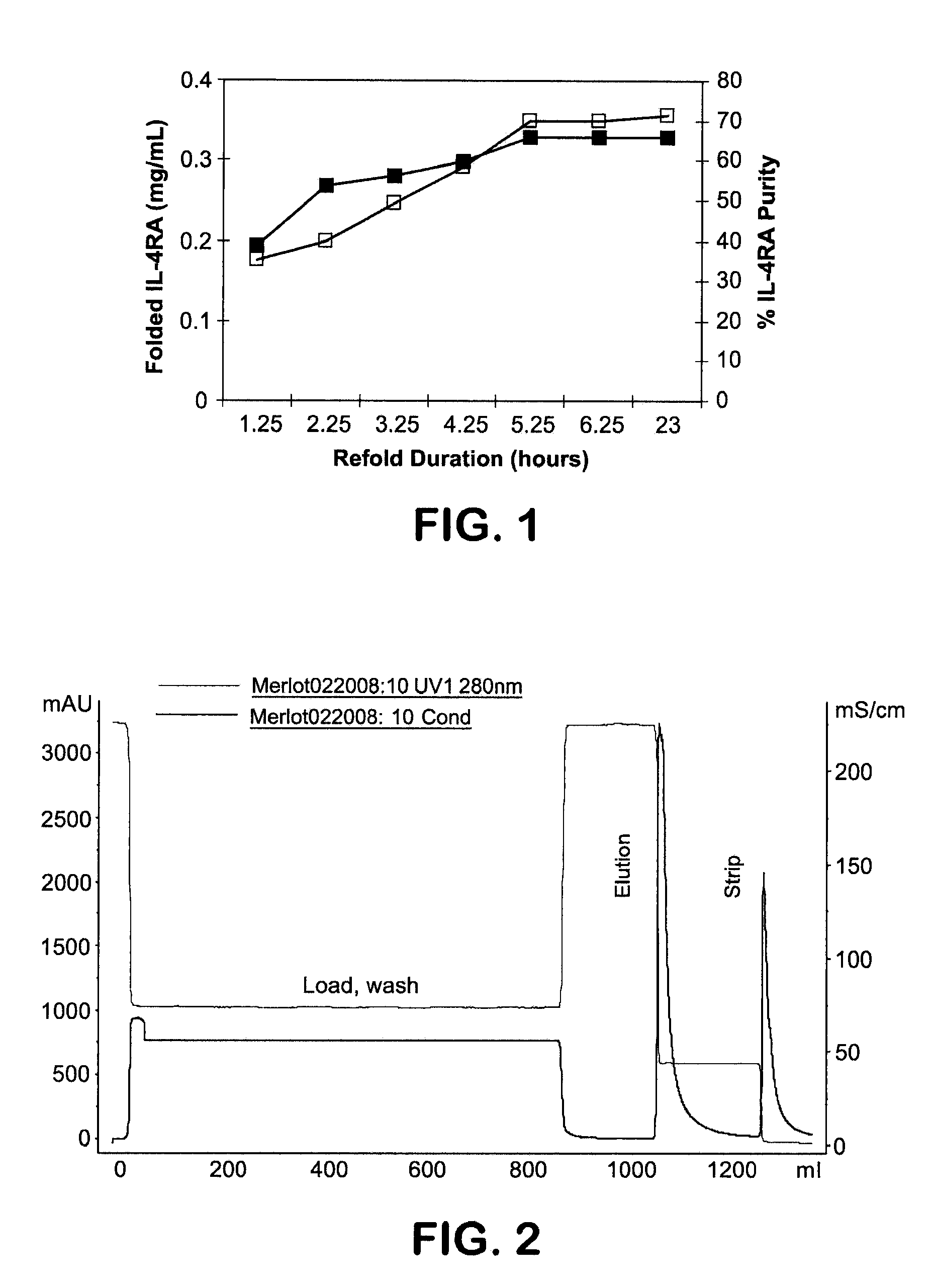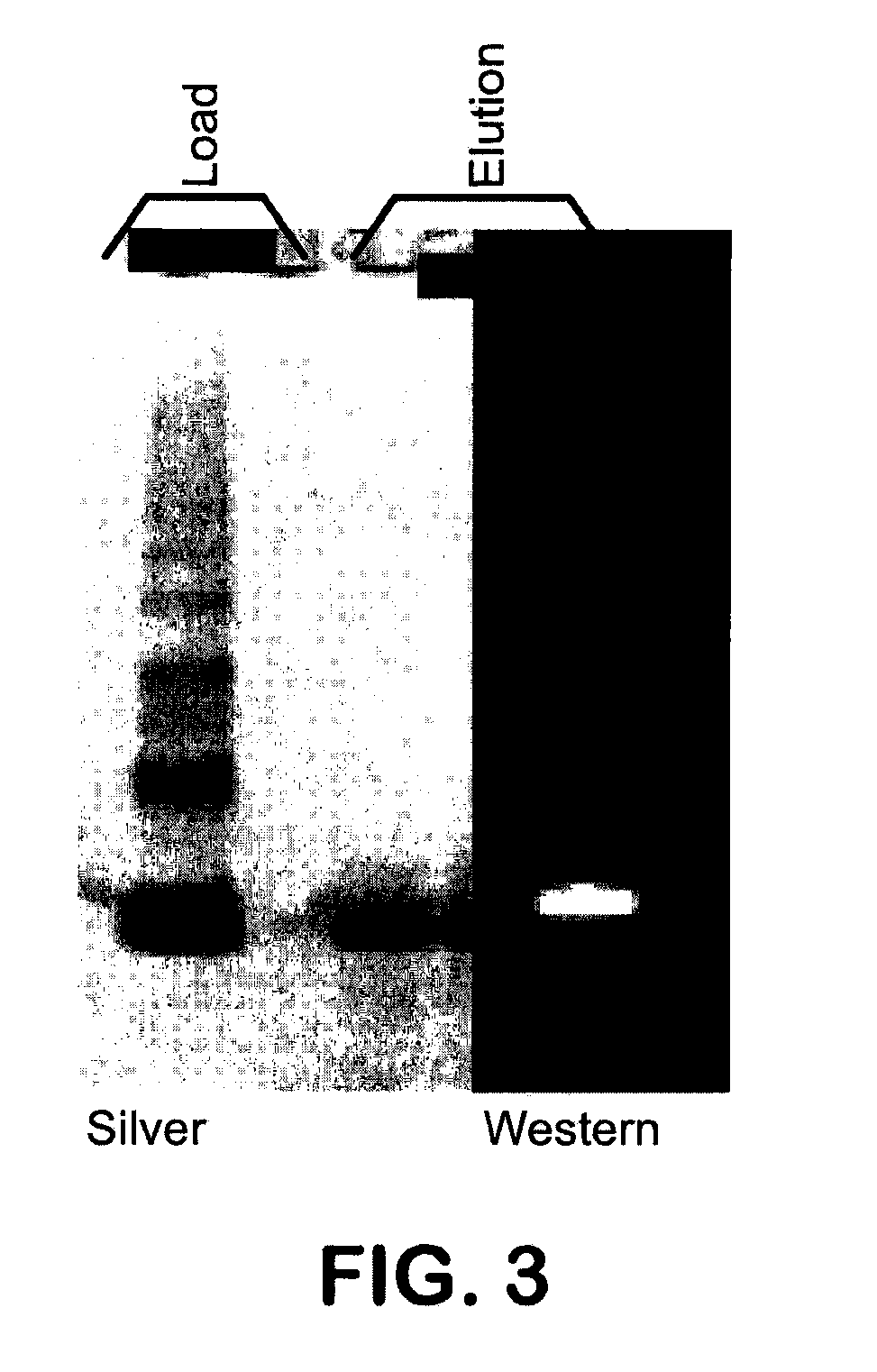Methods of renaturation of recombinant proteins
a technology of recombinant proteins and recombinant eukaryotic proteins, which is applied in the field of renaturation of recombinant, eukaryotic proteins, can solve the problems of /sub>4/sub>by adding sulfuric acid to tris-base, which poses hazards at the larger manufacturing scal
- Summary
- Abstract
- Description
- Claims
- Application Information
AI Technical Summary
Benefits of technology
Problems solved by technology
Method used
Image
Examples
example 1
Analytical Assays
[0078]SDS-PAGE / Coommassie Blue—Denaturing, reducing polyacrylamide gel electrophoresis followed by Coomassie or Silver staining was used for determination of content and purity of the protein in PDSP, refold and purified samples. Samples were diluted in either 5M urea (PDSP) or H2O (others), 4× NuPAGE® sample buffer and reducing agent, and heated to 70° C. for 10 minutes. Samples and the protein standard were loaded onto a 10 or 12-well NuPAGE® 4-12% Bis-Tris Gels (Invitrogen, 1 mm thickness) with MES running buffer under both reduced and non-reduced conditions. SDS-PAGE molecular weight standards (Mark 12, Invitrogen) were also loaded. The gels were run at 200 volts for about 40 minutes and then stained with either GelCode Blue COOMASSIE® Stain (Pierce Biotechnology) or SILVERXPRESS® Silver Staining Kit (Invitrogen) according to manufacturers instructions. Coomassie Stained Gels were imaged using Kodak Digital Image Stations 440CF and band intensity measured. The c...
example 2
Preparation of Starting Materials
[0083]Cell lysis—At small scale, cells are suspended in Break Buffer containing 50 mM Tris, 2 mM EDTA, pH 7.5 and lysed using a Micofluidizer (Microfluidic Corp) by passing the cell suspension through three times at 10,000 to 15,000 psi. The machine and cooling coil chamber was packed with ice during the run.
[0084]Inclusion Body Washing—Inclusion bodies (IBs) were collected by centrifugation for 30 minutes at 6000 RPM. The inclusion body pellet was washed with 10× (wet weight) IB Wash Buffer containing 50 mM Tris, 2 mM EDTA, and 1% triton X-100, pH 7.5. For each cycle of washing, the pellet was resuspended in buffer and stirred on ice for 30 to 60 minutes to overnight at 4° C. prior to harvesting by centrifugation. A total of 3 washes were performed.
[0085]IB Slurry Preparation—A slurry was made by resuspending the final IBs in a volume (in milliliters) of IB Wash Buffer equivalent to the amount of grams wet-weight of the total IB pellet. The suspensi...
example 3
Inclusion Body Solubilization and Sulfitolysis
[0086]IL-4RA inclusion bodies (IB) were prepared in a slurry (35-50%) in 50 mM Tris, pH 7.5, 5 mM EDTA, 0.1% Triton X-100. Because there is variation in the slurry percentage in the aliquots, the slurry was first centrifuged for 20 minutes at 6000 RPM. The liquid was poured off, the weight of the IBs determined, and a 50% slurry made by addition of an equal amount of buffer (w / v) followed by complete resuspension. The 50% slurry was dissolved in a 7.5 fold volume of 8 M guanidine, 0.2 M Tris, pH 7.5 or 9, and 5 mM EDTA. Sodium sulfite was added to a concentration of 5 g / L and the solution stirred for 30 minutes at room temperature. Potassium tetrathionate was added to 10 g / L and the solution stirred for an additional 60 minutes to 3 hours. The mixture was filtered and stored at 4° C. for a maximum of 20 hour before ultrafiltration / diafiltration (UF / DF). The target protein concentration is 10 g / L, as determined by Bradford assay.
[0087]IL-...
PUM
| Property | Measurement | Unit |
|---|---|---|
| Fraction | aaaaa | aaaaa |
| Fraction | aaaaa | aaaaa |
| Time | aaaaa | aaaaa |
Abstract
Description
Claims
Application Information
 Login to View More
Login to View More - R&D
- Intellectual Property
- Life Sciences
- Materials
- Tech Scout
- Unparalleled Data Quality
- Higher Quality Content
- 60% Fewer Hallucinations
Browse by: Latest US Patents, China's latest patents, Technical Efficacy Thesaurus, Application Domain, Technology Topic, Popular Technical Reports.
© 2025 PatSnap. All rights reserved.Legal|Privacy policy|Modern Slavery Act Transparency Statement|Sitemap|About US| Contact US: help@patsnap.com


